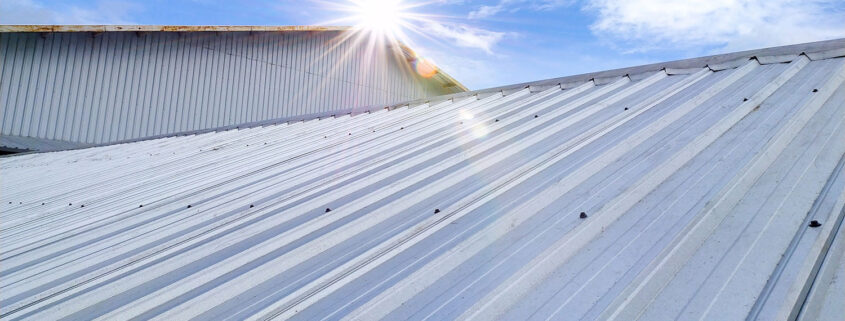Now more than ever before, eco-friendly roofing is available to the masses, and the motivation to install a more energy-efficient roof is at an all-time high. With benefits like reduced electricity costs and more efficient heating and cooling, it’s no wonder that the demand for this type of roofing has increased so significantly in popularity.
There are many different sustainable roofing types out there, each with advantages and disadvantages. So, here is your list of the most popular and efficient eco-friendly options. It’s important that before you decide whether or not to get a new roof installed, you understand which type of roofing is best for you.
Cool Roofing
Cool roofing, also known as white roofing, is a popular option among business owners. This roofing type most often includes reflective, light-colored single-ply membranes, modified bitumen, reflective coatings, and green (vegetative) roofing (highly reflective tiles and asphalt shingles are also available, but not commonly used on low-slope commercial roofing).
The color and reflective properties reduce the amount of heat that is absorbed, leading to lower cooling costs and more efficient energy consumption. Cool roofs also have better longevity than many standard roofing types.
The major downside of cool roofing is the cost. Due to the unique nature of the materials, the installation costs for cool roofs are typically higher than standard commercial roofing. Because of this, the investment for cool roofing is often the best option for buildings hit directly by the sun’s rays for significant time periods.
Clay Tiles
Clay tiles are also an efficient roofing material, from a temperature regulation perspective. However, they are different than cool roofs. Instead of reflecting heat, clay tiles without a reflective coating allow heat to circulate. This helps reduce the amount of time you need to run air conditioning and lowers your carbon footprint (and your energy bill). Clay tiles are also fire-resistant.
Clay roofing has two prevalent disadvantages, though. First, much like other eco-friendly roofing materials, clay roofing is more expensive than standard roofing materials. Second, clay tiles are much heavier than other roofing options. Due to the extra weight, you might need to add extra support before roof installation so the roof system is not compromised under the weight.
Much like slate tiles, clay tiles have a great lifespan but they can break more easily. However, that breakability is negligible since they are easily replaceable. (Think of the roofing lifespan on properties from a century ago that still have strong, intact clay or slate roofs! Compare that to wood shingle roofing products – while they’re replaceable, they have a short lifespan and aren’t typically used on commercial roofs.)
Metal Roofing
Metal roofs are one of the most popular eco-friendly roofs. While they are more expensive, metal is very effective as a commercial roofing material. Light-colored metal roofing has reflective properties that keep your building cooler, therefore lowering energy consumption.
Metal roofing is also extremely durable and low maintenance. A high-quality metal roof can last for several decades before you need roof replacement, and building materials can either be new or recycled materials!
The main issue with metal roofs is that they can’t be used on low-slope commercial roofs due to runoff concerns. These types of systems need at least a 3:12 pitch.
Solar Roofing
Solar roofing is an increasingly popular option for commercial roofs in good condition. They are typically attached to a flat roof in two ways: ballasted (using weights) or attached racking (using hardware to attach panels to the roofing material). New technology for solar panel shingles is creeping into the market, but they are not appropriate for flat roofs. That said, they could be considered for pitched roof designs or as an accent on a building that includes both flat and pitched design.
Solar roofs are among the most enticing, environmentally friendly roofing types available today. This is because solar panels, although expensive, save thousands of dollars in energy costs in the long run. Not only does the energy created by solar panels save you money as the owner, but also, the renewable energy produced has a significant positive environmental impact.
Living Roofs
Living roofs, also known as green roofs, are the most unique eco-friendly roof type there is. (Living roofs are essentially rooftop gardens.) What sets these roofs apart from other common, environmentally friendly materials? Living roofs can aid in improving the air quality!
The durability of green roofs, along with their overall benefits to the environment, makes them one of the highest-quality roofs in the world in terms of sustainability.
Although unique and beneficial to the environment, they are very expensive to install and maintain. You often need to add more structural support to the building to account for the extra weight of the roof, and the maintenance of the plants atop your building is extensive and constant.
Is Eco-Friendly Roofing Right For You?
Each building is different, and it is important to take the proper time and care to make the right decision about your commercial roof. Depending on how much exposure to the sun’s rays, the location, structure, weather conditions, etc., any one of these eco-friendly roofing options could be right for you!
If you need help with your commercial roofing, that’s where TEMA Roofing comes in. We offer a wide variety of roofing services across the nation, including installation, maintenance, repair, and replacement. If you need help with your roofing situation or want to assess options for multiple buildings within your organization, just reach out to us. We’re happy to help you get started!




